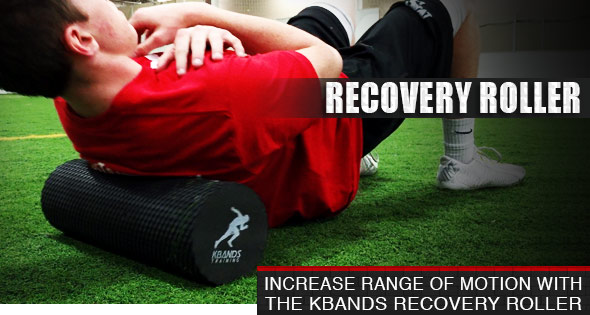How To Stretch Biceps | Foam Roll Bicep
Learning how to stretch biceps can be a tricky endeavor. The biceps are a unique group of muscles located on the front side of the upper arm, which work to provide flexion and aid the triceps in stabilizing the forearm. The bicep is made up of two main muscles, which aid in moving the arms, biceps brachii and the brachialis.
The biceps brachii are the muscles which make up the “bulge” in the middle of the bicep, while the brachialis is a much deeper bicep muscle located in the middle outside of the upper arm. These muscles main responsibility is to flex the forearm at the elbow. However, these muscles play a large roll in many other movements. The biceps primarily assist in pulling movements such as pull-ups or rowing exercises but also aid in forearm rotation.
A gymnast performing a routine on the rings or high bar will need additional bicep strength to aid in pulling themselves onto the bar or rings, but also to stabilize the forearms when performing their routine. During a lacrosse match the biceps play a key role in rotating the forearms, providing extra stability for powerful and accurate passes or shots.
How To Stretch Biceps: Bicep Brachii
The bicep brachii is the bulge which appears on top of the bicep. Foam rolling the bicep brachii will allow for greater flexion to occur, enhancing throwing and pulling movements made by athletes. To foam roll the bicep brachii athletes will begin by lying on their stomachs with a Recovery Foam Roller on the ground running parallel to their body. Athletes will extend their arms to the side and begin to foam roll their bicep by rolling the top part of the upper arm on the Recovery Foam Roller.
While learning how to stretch biceps athletes need to apply an adequate amount of pressure to the muscle and actively search for any trigger points which need to be released. Once a trigger point is located athletes will place a static hold for 15-20 seconds on the spot with the Recovery Foam Roller. After the initial hold athletes will perform 1-3 inch rolls around the same area to ensure all tension has been released and blood flow has been increased to the area. Athletes need to be thorough when foam rolling the biceps and be sure all trigger points are addressed. Perform the same foam rolling routine on the opposite arm.
How To Stretch Biceps: Brachialis
The brachialis is the muscle of the bicep located deeper in the upper arm. This muscle runs down the outside part of the humerous and its main function is to flex the arm. This muscle of the bicep is often associated with the width of the arm compared to the development of the bicep brachii which is associated with the “bulge” on the top of the bicep muscle.
To foam roll the brachialis athletes will lay the top part of their shoulder onto a Recovery Foam Roller. Athletes should perform a few rolls on the shoulder before going past the insertion point (the point where bicep and shoulder separate) and perform a static hold on the middle outside part of the arm. A static hold should be maintained for 15-20 seconds before rotating to the next arm. Although no rolling will take place during this bicep stretch athletes can slightly tilt their bodies forward and backward to ensure the entire bicep muscle is stretched.
How To Stretch And Warm-up The Biceps After Foam Rolling
Athletes need to utilize different forms of stretching to ensure the biceps are ready to perform once an athlete has properly learned how to stretch the biceps with the Recovery Foam Roller. Athletes can also learn how to stretch biceps using static and active warm-ups to properly activate or lengthen muscles for the specific function being performed.
Athletes can utilize static stretches to continue to prepare the body for physical activity after foam rolling the biceps. To perform a static stretch on the bicep athletes can utilize their hands or a wall. If a wall is being utilized athletes will straighten the arms out, open palms, point fingers down, and press their hands into the wall so the fingers are pointing down. Athletes can also use their hands when learning how to stretch biceps. Athletes will again extend the arm straight out and hold their hand up (like they are instructing someone to stop). From this point athletes will use the opposite hand to stretch the bicep by pulling the fingers back. This bicep stretch can also be performed with fingers pointing down. Although a stretch will mainly be felt in the forearm, the forearm muscle plays a key role in stimulating the bicep during physical activity.
When learning how to stretch biceps it is important to think about the specific movements the muscle is designed to perform. The biceps are designed to flex the forearm (decrease the angle between the lower and upper arm). This means that any pulling motion will involve the biceps. By learning how to stretch the bicep athletes will be able to increase the speed and strength of pulling motions. Soccer, football, and basketball players all perform short explosive pulls during competition, usually to gain an advantage on the field of play by moving or redirecting an opposing player.
The biceps are also activated when a throwing motion is executed. When a soccer or basketball player throw a ball the biceps are helping to stabilize the arm while the arms are being extended. Learning how to stretch the biceps, and other parts of the body, will greatly aid athletes in reaching their ultimate sport or fitness goal. Being proactive is always better than being reactive. Although the Recovery Foam Roller acts in both capacities it is important that athletes utilize the Rejuvenate Stretching Sequence to avoid injuries by properly preparing the muscles of the body for physical activity.

